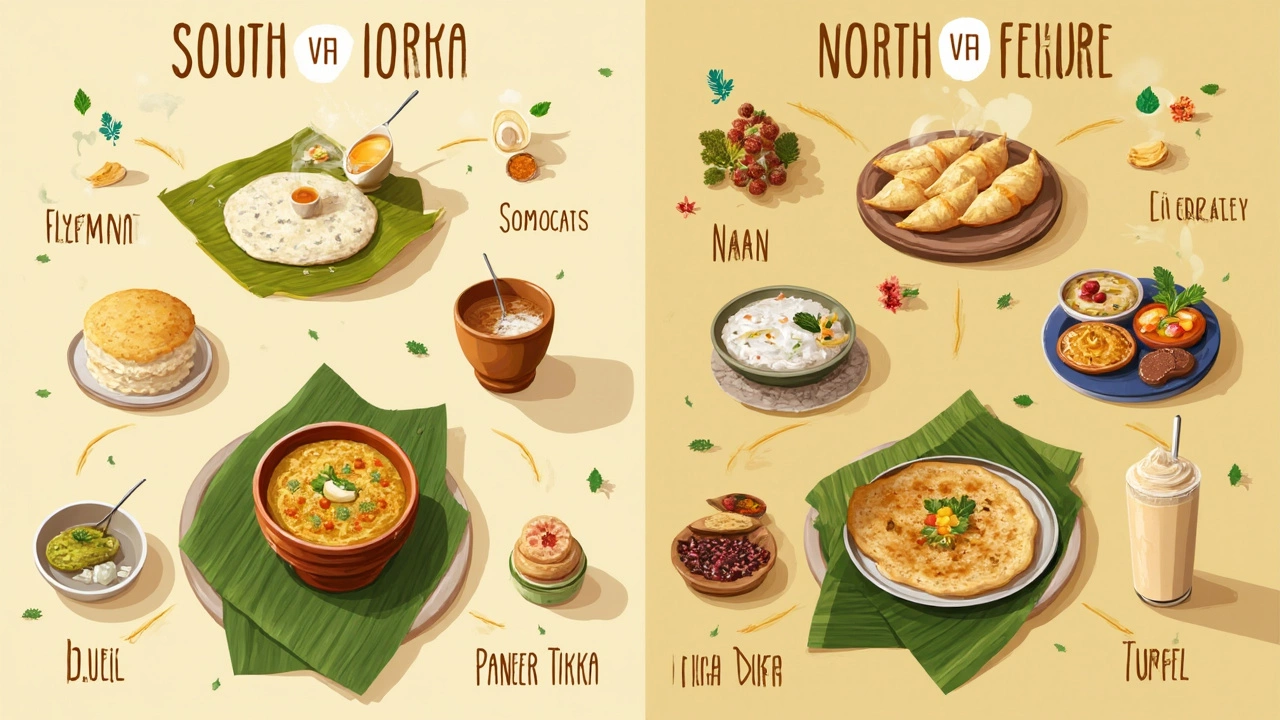If you’ve ever sat down at an Indian restaurant and hesitated between a steaming bowl of sambar and a plate of butter chicken, you already know the dilemma: Indian food isn’t just “Indian food.” India’s kitchen is really two different universes, and the rivalry between South Indian and North Indian cuisine has sparked epic debates at dinner tables around the world – yes, even here in Sydney where you sometimes have to pick sides at potlucks. If you think choosing between dosas and naan is tough, wait till you learn how deep the differences actually go. But don’t panic – you’re about to get the facts and flavours that’ll help you pick your champion or maybe discover it’s not even a competition after all.
Breaking Down Flavours: Distinctive Tastes of North and South Indian Food
Let’s call out the elephant in the room first: Indian food is not a single homogenous thing, and these two culinary traditions are as different as night and day. North Indian food is rich, creamy, and bold – imagine curries swirled with cream, butter, and ghee. Think of that hearty satisfaction when you mop up a thick dal makhani with soft, pillowy naan. Tandoor ovens lend a smoky flavour to breads and meats, still hard to replicate at home unless you like burning your eyebrows off. Spices like garam masala, cardamom, cinnamon, and cumin are everywhere. You’ll spot plenty of paneer (Indian cottage cheese), yoghurt, and dried fruits. Street favourites include samosas, chole bhature, and kebabs.
In contrast, South Indian food is a rollercoaster of tangy, spicy, and sometimes fermented goodness. The best-known dishes are dosas (crispy fermented rice and lentil crepes), idlis (steamed rice cakes), tangy sambar, rasam soups, and masala vadas. Coconut and curry leaves rule in almost every dish, and there’s a freshness here that rarely gets heavy or oily. There’s plenty of vegetarian options but seafood and spicy meats like Andhra chicken curry or Chettinad pepper roast pack a serious punch for meat lovers. Chutneys in all kinds of colours and textures are essential – coconut, tomato, mint, peanut, the list goes on.
Here’s a quick flavour match-up in a table, so you can see where these cuisines stand apart:
| Cuisine | Main Ingredients | Common Spices | Signature Dishes |
|---|---|---|---|
| North Indian | Wheat, dairy, meats | Garam masala, cumin, coriander, cardamom, kasuri methi | Butter chicken, naan, dal makhani, samosa |
| South Indian | Rice, lentils, coconut, seafood | Curry leaves, mustard seeds, dried red chilli, tamarind, asafoetida | Dosa, idli, sambar, fish curry |
Think about what your tastebuds are craving. If you dream about rich, comforting curries, North India might win your heart. If you love bold, sour, and sometimes fiery flavours, South India just might surprise you.
Ingredients and Cooking Styles: More Than Just Curry
Look at your pantry: if you see wheat flour, ghee, and a tub of yoghurt staring back at you, you’re set for a quick North Indian dinner. Staples here revolve around wheat – so you get all sorts of breads from fluffy naan to crisp parathas to spicy stuffed kulchas. Cooking methods are pretty hands-on: tandoor ovens (big clay ovens) for baking and roasting, deep frying for snacks, and a heavy hand with cream and butter for those “special occasion” gravies. The way heat is managed in North Indian food is unique: it goes for warming spices, slow-cooked meats, and family-sized pots of food that can last a week.
South Indian pantries read like a vegan’s paradise: rice, urad dal (black lentils), split chickpeas, coconut, tamarind, and a battalion of whole spices. Most of these dishes use steaming, sautéing, and fermentation for unique textures and tangy depth. If you’ve ever wondered why South Indian breakfast feels so light but filling, it’s because fermented batters for dosa and idli are easy to digest. Oils are lighter (coconut and sesame rule), and fresh herbs like coriander and curry leaves end up tossed on top of everything.
Diversifying your Indian food at home? If you love meal prepping, dosas and sambars are super cost-effective and freeze well. For rich party feasts, nothing beats a North Indian biryani or creamy korma. Here’s a smart tip: South Indian food can be gluten-free with ease, so it’s perfect if you’re dodging wheat.

Health and Nutrition: Which One’s Better For You?
Everyone wants to know which one of these cuisines is “healthier,” but the truth isn’t so black and white.
North Indian food has a bit of a reputation for being rich in fats – those creamy gravies, fried starters, and cheese-heavy mains can make a dent in your calorie count in no time. Even the breads – naan, puri, bhature – often get made with white flour (maida) and plenty of ghee or oil. But it’s not all waistline doom: lentil stews, grilled meats, and veggie side dishes pack in protein and nutrients.
South Indian food tends to be lighter, relying on steamed or fermented foods (idli, dosa), less oil, and tons of vegetables. The native use of coconut isn’t just for flavour – it provides healthy fats and a good amount of fibre. Fermented foods are also brilliant for gut health because they’re practically prebiotics in disguise. If you're watching your calorie and fat intake, a South Indian style meal is likely to fill you up without leaving you groggy.
If you dig into the numbers, here’s an easy comparison for a typical meal:
| Meal | Calories | Main Nutrients |
|---|---|---|
| North Indian Thali | 900–1200 | Protein (lentils/meat), Fat (ghee), Carbs (naan/rice) |
| South Indian Tiffin (Idli, Sambar) | 400–700 | Protein (lentils), Fibre (veggies), Low Fat |
The score? If you eat with portion control and choose wisely, both cuisines can be part of a healthy lifestyle. But those watching the scales often edge toward South Indian eats for their lighter feeling and high fibre count.
Culture, History, and Festival Plates
Food in India is never just about hunger – every dish has a history, and every meal is wedded to a bunch of traditions. North Indian food is often tied to Mughal influences (think lavish banquets, slow-cooked meats, biryanis laden with saffron and nuts) and it flourished in the cooler climates of Punjab, Delhi, and Rajasthan. The communal sharing of “thali” platters stacked with little bowls shows up at pretty much any wedding, holiday, or Sunday family reunion. For festivals like Holi and Diwali, sweet treats like gulab jamun, jalebi, and laddoo aren’t just dessert – they’re part of the celebration itself.
In the south, food is about batches, sharing, and a bit of practicality – meals are often served on banana leaves, sometimes eaten with your hands (so you never miss out on any flavour), and the spread features pickles, yoghurt, and endless relishes. Pongal (a sweet or savoury rice and lentil dish) marks the South Indian harvest festival, while special seafood curries appear for regional occasions. Here’s a quirky tip: the filter coffee culture in Chennai rivals Sydney’s café scene, and no meal down south is really complete without it.
Travel tip for foodies: If you find yourself in India, don’t get caught eating only city food. Taste the homestyle stuff in each region – Hyderabad biryani in the North, Kerala fish curry in the South. Your taste buds will thank you for the adventure.

Practical Tips: How to Choose (or Combine) The Best of Both Worlds
Deciding between South and North Indian food is like picking your favourite song – it really depends on the mood. If you’re torn, try mixing it up: have a dosa for breakfast, curry and roti for lunch, and maybe a fragrant biryani for a celebratory dinner. Modern Indian restaurants in Sydney and pretty much anywhere else often borrow from both these traditions, so you can enjoy the best of both worlds with one order.
If you’re new to Indian cooking at home, start simple. Get a spice box (masala dabba) and fill it with the must-haves: turmeric, chilli, cumin, coriander, mustard seeds, and garam masala. For North Indian food, don’t skip the ginger-garlic paste and get to know your pressure cooker. For South Indian food, invest in a good non-stick tawa for dosas, and keep tamarind paste and fresh coconut on hand. Even just learning how to make sambar or dal opens up loads of weekday meal options.
And if you’re still arguing with your mates about which cuisine is the real winner, remember this: each offers a different angle on spice, soul, and satisfaction. If you’re lucky enough to have both styles available in your city, turn it into a monthly ritual to try a new dish from each. Your mouth (and maybe your Instagram) will never be bored again.
Whichever plate you reach for first – North Indian or South Indian – you’ll discover that Indian cooking isn’t about one style being better than another. It’s about the adventure, the stories, and the memories you create with every meal. So grab that dosa or dig into that butter chicken, and enjoy the ride – because Indian food, in all its forms, is too good for just one answer.



